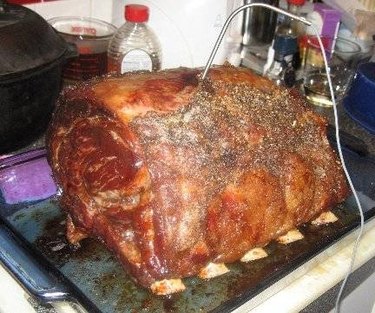
Prep the Roast
Roasts cooked in convection ovens will reach up to 30 degrees higher internally than roasts cooked in traditional ovens in the same amount of time. If you want your roast to come out perfectly, measure its doneness with a meat thermometer instead of by the amount of time that it has cooked.
Trim fat in excess of 1 inch from all sides of the roast, and allow the roast to sit loosely covered until it has reached room temperature--about 2 hours after you get it out of the refrigerator or much longer if frozen.
Video of the Day
Video of the Day
Pat and Place in Pan
Rinse the roast and pat it dry with a paper towel. Spread butter all over the cut edges of the roast, sprinkle with salt and pepper to taste and place it inside a deep roasting pan that will fit inside your convection oven. (Do not use non-stick pans, as the surface can leach toxic chemicals into your pan juices.)
Cook
Place the roast, fat side up, into the convection oven set at the highest temperature (around 450) for 15 minutes, then lower the temperature to 325 degrees Fahrenheit, and check and baste it every 1/2 hour.
Cook and Remove
Check the roast with an internal meat thermometer about 1/2 hour before the estimated end of the roasting time.
For a 4-to-6 lb. roast, it should cook in about an hour; 7 to 8 1/2 lbs. will cook in about 1 3/4 hours; up to 2 1/4 hours for 9 to 10 1/2 lbs.; 11 to 13 1/2 lbs. will be ready in 2 3/4 hours; 14 to 16 1/2 lbs. in 3 1/4 hours; and up to 4 hours for 16 to 18 1/2 lbs.
Insert a meat thermometer and remove it when it reaches 110 degrees for rare roast; 115 to 120 degrees for medium rare; and 125 degrees for medium doneness.
Allow the cooked rib roast to sit for at least 20 minutes before serving. The internal temperature will remain hot during this time, and the juices will be locked into the meat. The roast will continue to cook, so don't let it sit too long.